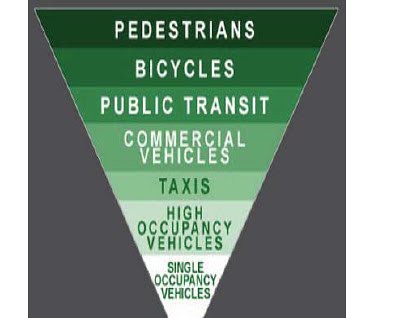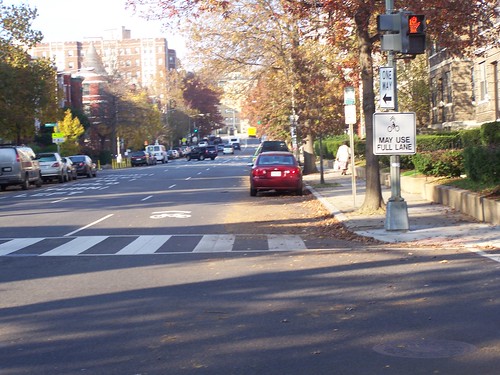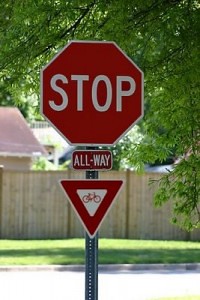Washington Post celebrates National Bike Safety Month by admonishing bicyclists
US DOT Secretary Ray LaHood in his blog entry, "NHTSA, AAA join together for National Bike Safety Month with new "Roll Model" campaign," tells us that the best thing bicyclists can do is be a positive "roll model" and teach by example.
But there is no question that on 20-30 pound bikes, and weighing 100-220 pounds, that cyclists are relatively unequal to motor vehicles, which are 2,000 to 4,000 pounds in weight, and have the capability to go 100+ mph.
I didn't feel that today's Post editorial, "Bicyclists welcome," made me feel welcome. The full title of the editorial is "Bicyclists are welcome in D.C., but they, too, should obey the law."
Here are the first and last paragraphs of the editorial:
ENCOURAGED BY smart urban transit policies, the District of Columbia has seen a surge in the number of bicyclists. It’s a trend that should be celebrated and fostered. At the same time, it spotlights the need for better public education and enforcement of traffic rules to prevent accidents. ...
The Washington area’s spring StreetSmart campaign, which featured increased public education and enforcement of traffic laws to highlight pedestrian-cyclist safety, was commendable but has come to an end. Traffic safety laws need to be enforced year-round. We would urge city officials who seek to make the District more bike-centric not to shirk on getting people — no matter if they are driving or riding — to follow the laws.
Of course bicyclists should follow the law (provided that the Idaho Stop is enacted). That seems pretty innocuous, but the piece just didn't feel right.
I guess because really what is needed in order to reduce accidents are a wide ranging set of changes that go far beyond "traffic enforcement." Instead, the editorial gently blames bicyclists for not riding within the laws. I wish the editorial would have stepped up and called for significant changes, instead of pablum.
1. Really, what the editorial should have called for is "democratizing the streets," and a sustainable transportation vision for the city, with regard to sustainable transportation vis-a-vis the automobile.

Sustainable transportation hierarchy. Transportation Alternatives.
See the piece "Democratizing the Streets," from the San Francisco Bay Guardian for more on this idea, which isn't different from what I discuss, generally in terms of placemaking and optimal mobility as being the foundations of urban, specifically DC, transportation policy.
2. Recommendation: Police departments, planning departments, and transportation departments need to come together and set up a protocol to systematically evaluate each pedestrian and bicycle accident in order to determine if there are structural issues "causing" accidents.
The best way to do this is to implement the BIKESAFE and PEDSAFE accident investigation and countermeasure protocols from the FHWA.
The Post editorial states that police investigations find that cyclists are at fault more than motor vehicle operators.
But the editorial doesn't mention that police training with regard to accident investigation is biased in favor of the motor vehicle operator.
3. The editorial doesn't mention that because an automobile is so much more dangerous than a pedestrian or a bicyclist, that the operators of motor vehicles should be required to have more responsibility, not an "equal" responsibility, based on the relative dangerousness of the vehicle.
Recommendation: change legal procedures so that motor vehicle operators are held to a higher degree of responsibility for all accidents involving pedestrians and/or bicyclists. This is done in the Netherlands.
See the past blog entry, "In times of change, too often, discourse is wacked: bicycle/pedestrian edition)" for more discussion about this topic.
4. Recommendation: modify drivers education and drivers license renewal processes to better cover traffic safety, including pedestrian and bicyclist safety.
Most drivers license renewal processes don't require drivers to retake any tests. Instead, refresher tests should be required, in part as an educational tool, to cover key factors in accidents--operating motor vehicles safely, in order to reduce the likelihood of accidents.
This means questions concerning bicyclists, pedestrians, driver inattention, road rage, etc.
5. Recommendation: extend bicycle and pedestrian training through all levels of K-12 education.
Teen driving deaths and teen deaths on bicycles and when walking demonstrate that the limited education provided on traffic safety, and walking and bicyclist education, which is typically provided, at least in this region, only from kindergarden to third grade, is inadequate.
Curricula should be developed to cover the higher elementary grades, middle school, and high school.
6. Recommendation: The Federal Safe Routes to School program only covers grades K-8. It should be extended to cover high school ages also, although at that level, there should be a greater focus on bicycle education.
7. There has been extended discussion on the Washcycle blog about motor vehicle operators and "sharing the road." See the entry "That’s safe cycling, not arrogance, says MDOT," about whether or not bicyclists should be forced to use sidepaths when they are available, and the law, and a surprisingly forceful letter by the Maryland DOT bicycle and pedestrian planner, Michael Jackson, on the subject. Note that in the comments, there is a particular good one by Jack Cochrane, chair of the Montgomery County Bicycle Advocates.
Many motor vehicle operators believe that bicyclists aren't allowed to use the road, or that "sharing the road" means that the slower "vehicle" in this case bicycles, both yields and is subservient to motor vehicles.
That's not what share the road means. Some people recommend that instead of share the road signs, a different sign "bicycles may use full lane," should be the new standard. Below is a sign used on 15th Street NW. I think both the word bicycle and the icon of a bicycle should be used in such signs.

8. Recommendation: that the Idaho Stop, where cyclists can treat stop signs and red lights as "yields" provided there is no oncoming traffic or there are significant gaps in traffic, should be made the law of the land, starting in center cities.
While giving bicyclists priority over cars would never pass muster for a Post editorial, after all, automobile advertising is a far more significant source of revenue than that from bicycle retailers, from the standpoint of promoting optimal mobility, this is a necessary change.
See the past blog entries, "Safe bicycling and the right kind of infrastructure" and "Bicycling, time, and transportation demand management," for more on the Idaho Stop.

Labels: car culture and automobility, sustainable land use and resource planning, sustainable transportation, transportation planning, urban design/placemaking



0 Comments:
Post a Comment
<< Home